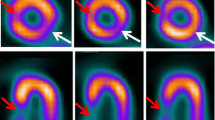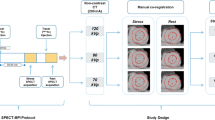Abstract
Purpose
Effective doses of 14 mSv or higher are currently being attained in patients having stress and rest myocardial perfusion imaging (MPI) single photon emission computed tomography (SPECT) performed on the same day with conventional protocols. This study aimed to assess the actual reduction in effective doses as well as diagnostic performances for MPI routinely planned with: (1) high-sensitivity cadmium zinc telluride (CZT) cameras, (2) very low injected activities and (3) a stress-first protocol where the normality of stress images may lead to avoiding rest imaging.
Methods
During a 1-year period, 2,845 patients had MPI on a CZT camera, a single-day stress-first protocol and low injected activities (120 MBq of 99mTc-sestamibi at stress for 75 kg body weight and threefold higher at rest). The ability to detect > 50 % coronary stenosis was assessed in a subgroup of 149 patients who also had coronary angiography, while the normalcy rate was assessed in a subgroup of 128 patients with a low pretest likelihood of coronary artery disease (<10 %).
Results
Overall, 33 % of patients had abnormal MPI of which 34 % were women and 34 % were obese. The mean effective doses and the percentage of exams involving only stress images were: (1) 3.53 ± 2.10 mSv and 37 % in the overall population, (2) 4.83 ± 1.56 mSv and 5 % in the subgroup with angiography and (3) 1.96 ± 1.52 mSv and 71 % in the low-probability subgroup. Sensitivity and global accuracy for identifying the 106 patients with coronary stenosis were 88 and 80 %, respectively, while the normalcy rate was 97 %.
Conclusion
When planned with a low-dose stress-first protocol on a CZT camera, MPI provides high diagnostic performances and a dramatic reduction in patient radiation doses. This reduction is even greater in low-risk subgroups with high rates of normal stress images, thus allowing the mean radiation dose to be balanced against cardiac risk in targeted populations.




Similar content being viewed by others
References
Einstein AJ. Effects of radiation exposure from cardiac imaging: how good are the data? J Am Coll Cardiol 2012;59(6):553–65.
Einstein AJ, Weiner SD, Bernheim A, Kulon M, Bokhari S, Johnson LL, et al. Multiple testing, cumulative radiation dose, and clinical indications in patients undergoing myocardial perfusion imaging. JAMA 2010;304(19):2137–44.
Bedetti G, Botto N, Andreassi MG, Traino C, Vano E, Picano E. Cumulative patient effective dose in cardiology. Br J Radiol 2008;81(969):699–705.
Picano E, Vañó E, Rehani MM, Cuocolo A, Mont L, Bodi V, et al. The appropriate and justified use of medical radiation in cardiovascular imaging: a position document of the ESC Associations of Cardiovascular Imaging, Percutaneous Cardiovascular Interventions and Electrophysiology. Eur Heart J 2014;35(10):665–72.
Hesse B, Tagil K, Cuocolo A, Anagnostopoulos C, Bardiés M, Bax J, et al. EANM/ESC procedural guidelines for myocardial perfusion imaging in nuclear cardiology. Eur J Nucl Med Mol Imaging 2005;32(7):855–97.
Holly TA, Abbott BG, Al-Mallah M, Calnon DA, Cohen MC, DiFilippo FP, et al. Single photon-emission computed tomography. J Nucl Cardiol 2010;17(5):941–73.
Verger A, Djaballah W, Fourquet N, Rouzet F, Koehl G, Imbert L, et al. Comparison between stress myocardial perfusion SPECT recorded with cadmium-zinc-telluride and Anger cameras in various study protocols. Eur J Nucl Med Mol Imaging 2013;40(3):331–40.
Kapur A, Latus KA, Davies G, Dhawan RT, Eastick S, Jarritt PH, et al. A comparison of three radionuclide myocardial perfusion tracers in clinical practice: the ROBUST study. Eur J Nucl Med Mol Imaging 2002;29(12):1608–16.
Robinson CN, van Aswegen A, Julious SA, Nunan TO, Thomson WH, Tindale WB, et al. The relationship between administered radiopharmaceutical activity in myocardial perfusion scintigraphy and imaging outcome. Eur J Nucl Med Mol Imaging 2008;35(2):329–35.
Taillefer R, Gagnon A, Laflamme L, Grégoire J, Léveillé J, Phaneuf DC. Same day injections of Tc-99m methoxy isobutyl isonitrile (hexamibi) for myocardial tomographic imaging: comparison between rest-stress and stress-rest injection sequences. Eur J Nucl Med 1989;15(3):113–7.
Heo J, Kegel J, Iskandrian AS, Cave V, Iskandrian BB. Comparison of same-day protocols using technetium-99m-sestamibi myocardial imaging. J Nucl Med 1992;33(2):186–91.
Imbert L, Poussier S, Franken PR, Songy B, Verger A, Morel O, et al. Compared performance of high-sensitivity cameras dedicated to myocardial perfusion SPECT: a comprehensive analysis of phantom and human images. J Nucl Med 2012;53(12):1897–903.
Verger A, Imbert L, Yagdigul Y, Fay R, Djaballah W, Rouzet F, et al. Factors affecting the myocardial activity acquired during exercise SPECT with a high-sensitivity cardiac CZT camera as compared with conventional Anger camera. Eur J Nucl Med Mol Imaging 2014;41(3):522–8.
Gimelli A, Bottai M, Quaranta A, Giorgetti A, Genovesi D, Marzullo P. Gender differences in the evaluation of coronary artery disease with a cadmium-zinc telluride camera. Eur J Nucl Med Mol Imaging 2013;40(10):1542–8.
Gimelli A, Bottai M, Giorgetti A, Genovesi D, Filidei E, Marzullo P. Evaluation of ischaemia in obese patients: feasibility and accuracy of a low-dose protocol with a cadmium-zinc telluride camera. Eur J Nucl Med Mol Imaging 2012;39(8):1254–61.
Duvall WL, Croft LB, Ginsberg ES, Einstein AJ, Guma KA, George T, et al. Reduced isotope dose and imaging time with a high efficiency CZT SPECT camera. J Nucl Cardiol 2011;18(5):847–57.
Duvall WL, Slomka PJ, Gerlach JR, Sweeny JM, Baber U, Croft LB, et al. High-efficiency SPECT MPI: comparison of automated quantification, visual interpretation, and coronary angiography. J Nucl Cardiol 2013;20(5):763–73.
Nakazato R, Berman DS, Hayes SW, Fish M, Padgett R, Xu Y, et al. Myocardial perfusion imaging with a solid-state camera: simulation of a very low dose imaging protocol. J Nucl Med 2013;54(3):373–9.
Sharir T, Ben-Haim S, Merzon K, Prochorov V, Dickman D, Ben-Haim S, et al. High-speed myocardial perfusion imaging initial clinical comparison with conventional dual detector Anger camera imaging. JACC Cardiovasc Imaging 2008;1:156–63.
Sharir T, Slomka PJ, Hayes SW, DiCarli MF, Ziffer JA, Martin WH, et al. Multicenter trial of high-speed versus conventional single-photon emission computed tomography imaging: quantitative results of myocardial perfusion and left ventricular function. J Am Coll Cardiol 2010;55(18):1965–74.
Gibbons RJ, Balady GJ, Beasley JW, Bricker JT, Duvernoy WF, Froelicher VF, et al. ACC/AHA guidelines for exercise testing: executive summary. A report of the American College of Cardiology/American Heart Association Task Force on Practice Guidelines (Committee on Exercise Testing). Circulation 1997;96(1):345–54.
Marie PY, Danchin N, Branly F, Angioï M, Grentzinger A, Virion JM, et al. Effects of medical therapy on outcome assessment using exercise thallium-201 single photon emission computed tomography imaging: evidence of a protective effect of beta-blocking antianginal medications. J Am Coll Cardiol 1999;34(1):113–21.
Marie PY, Mercennier C, Danchin N, Djaballah K, Grentzinger A, Zannad F, et al. Residual exercise SPECT ischemia on treatment is a main determinant of outcome in patients with coronary artery disease treated medically at long-term with beta-blockers. J Nucl Cardiol 2003;10(4):361–8.
David N, Marie PY, Angioi M, Rodriguez RM, Hassan N, Olivier P, et al. Dipyridamole and exercise SPECT provide different estimates of myocardial ischaemic areas: role of the severity of coronary stenoses and of the increase in heart rate during exercise. Eur J Nucl Med 2000;27(7):788–99.
Cousins C, Miller DL, Bernardi G, Rehani MM, Schofield P, Vañó E, et al. ICRP Publication 120: radiological protection in cardiology.. Ann ICRP 2013;42(1):1–125.
Klocke FJ, Baird MG, Lorell BH, Bateman TM, Messer JV, Berman DS, et al. ACC/AHA/ASNC guidelines for the clinical use of cardiac radionuclide imaging–executive summary: a report of the American College of Cardiology/American Heart Association Task Force on Practice Guidelines (ACC/AHA/ASNC Committee to Revise the 1995 Guidelines for the Clinical Use of Cardiac Radionuclide Imaging). Circulation 2003;108:1404–18.
Gimelli A, Bottai M, Genovesi D, Giorgetti A, Di Martino F, Marzullo P. High diagnostic accuracy of low-dose gated-SPECT with solid-state ultrafast detectors: preliminary clinical results. Eur J Nucl Med Mol Imaging 2012;39(1):83–90.
Duvall WL, Sweeny JM, Croft LB, Ginsberg E, Guma KA, Henzlova MJ. Reduced stress dose with rapid acquisition CZT SPECT MPI in a non-obese clinical population: comparison to coronary angiography. J Nucl Cardiol 2012;19(1):19–27.
Esteves FP, Galt JR, Folks RD, Verdes L, Garcia EV. Diagnostic performance of low-dose rest/stress Tc-99m tetrofosmin myocardial perfusion SPECT using the 530c CZT camera: quantitative vs visual analysis. J Nucl Cardiol 2014;21(1):158–65.
Goto K, Takebayashi H, Kihara Y, Yamane H, Hagikura A, Morimoto Y, et al. Impact of combined supine and prone myocardial perfusion imaging using an ultrafast cardiac gamma camera for detection of inferolateral coronary artery disease. Int J Cardiol 2014;174(2):313–7.
Fiechter M, Ghadri JR, Kuest SM, Pazhenkottil AP, Wolfrum M, Nkoulou RN, et al. Nuclear myocardial perfusion imaging with a novel cadmium-zinc-telluride detector SPECT/CT device: first validation versus invasive coronary angiography. Eur J Nucl Med Mol Imaging 2011;38(11):2025–30.
Acknowledgments
The authors thank Pierre Pothier for critical review of the manuscript and the Nancyclotep experimental imaging platform for organizational support.
Compliance with ethical standards
ᅟ
Conflicts of interest
None.
Statement of human rights
For this type of study formal consent from participants is not required.
Author information
Authors and Affiliations
Corresponding author
Rights and permissions
About this article
Cite this article
Perrin, M., Djaballah, W., Moulin, F. et al. Stress-first protocol for myocardial perfusion SPECT imaging with semiconductor cameras: high diagnostic performances with significant reduction in patient radiation doses. Eur J Nucl Med Mol Imaging 42, 1004–1011 (2015). https://doi.org/10.1007/s00259-015-3016-7
Received:
Accepted:
Published:
Issue Date:
DOI: https://doi.org/10.1007/s00259-015-3016-7




